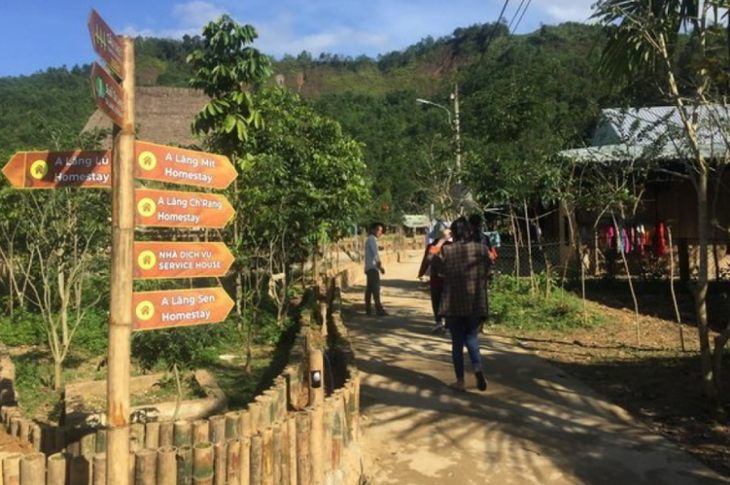
Ta Lang, a Co Tu community and ecotourism hamlet in Tay Giang district, Quang Nam province (Photo: VOV)
Green tourism aims for sustainable tourism development through environmental protection and the conservation and promotion of cultural heritages.
Ta Lang, a Co Tu community and ecotourism hamlet in Tay Giang district, Quang Nam province, is financed by the Green Truong Son project of the US Agency for International Development (USAID), the Vietnam Tourism Association, and the Vietnam Community Tourism Association. Since it opened to tourists in 2019, the village has gained dramatic results.
The Co Tu have rebuilt their Guol community houses, established a culinary group to prepare traditional dishes, and restored their knitting and brocade weaving crafts and folk arts such as call and response singing. Visitors come to enjoy the mountains and forests and an environment-friendly lifestyle free of disposable plastic. All household utensils here, including plates, straws, tables, and chairs, are made of bamboo and forest leaves.
A Lang Mit of Ta Lang hamlet says the Co Tu do green tourism to protect their heritages and natural resources while promoting their culture.
“The villagers are happy when they have guests. My house has hosted 160 guests already. Community tourism is growing, so people’s lives have become less difficult. They used to depend on farming and went hungry if the crop failed. Now their life is better,” said A Lang Mit.

A Gươl community house of the Co Tu is built at Ta Lang community and ecotourism hamlet in Tay Giang district, Quang Nam province. (photo: VOV)
Dong Giang, Tay Giang, and Nam Giang district in Quang Nam province and Nam Dong and A Luoi district in Thua Thien Hue share landscape and cultural similarities.
They have cooperated to offer tours to craft villages that produce weaving, fine art, and agricultural specialties. Tourists can trek in the forests, explore caves, and experience the local lifestyle.
Nguyen Thi Linh from Ho Chi Minh City said, “The most surprising thing is that the local hamlets are thriving. They all now have facilities to serve tourists. I’m surprised how quickly it developed. They offer a variety of services. Now they need to improve the quality. For example, the tour guides should be more professional.”
The ethnic groups living in the Truong Son Range have a rich cultural heritage. Visitors are as fascinated by the indigenous culture as they are by the majestic natural beauty.
Tourists flock to festivals like the drum breaking festival of the Macoong and the rice-harvesting festival of the Bru-Van Kieu.
Pham Van Thuy, Vice Chairman of the Vietnam National Administration of Tourism, said, “Ethnic communities in the Truong Son Range are blessed with abundant natural resources. Local tourism should preserve these natural resources while promoting the unique local cultures. Provinces should create policies that encourage tourism products based on local cultures, and tourism programs should connect scenery, heritages, and relic sites.”
Developing green tourism in the Truong Son Range opens new opportunities for ethnic communities. Provinces have collaborated and promulgated mechanisms to encourage enterprises to invest in and create new eco-friendly tourism products so that the Truong Son Range remains green and its cultural identity is preserved.